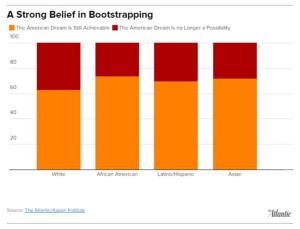Is the so-called “American Dream” dead? And why do whites and Blacks differ in their opinions of that Dream?
A new poll conducted by Penn Schoen Berland for The Atlantic and the Aspen Institute reveals some unexpected truths about how Black people and Latinos view the American Dream with regard to their white counterparts. While the poll of 2,000 respondents suggests that there is great pessimism across the nation—as 75 percent of people say The Dream was suffering and one quarter say it is alive and well—the true story behind the numbers lies in the racial breakdown.
More than four out of five white millennials, as well as whites between the ages 51 and 64, believe The Dream is suffering. Meanwhile, 43 percent of African-Americans, 36 percent of Latinos and significant numbers of Asian Americans believe The Dream is a reality and is achievable to those who want to work hard and strive to accomplish it. Meanwhile, 80 percent of Blacks feel America’s best days are ahead, but fewer than half of whites agree with that statement.

Yet, even if Black people are having it hard, as they have for the hundreds of years they have been in America, they are able to point to their legacy of perseverance against injustice, their faith, and support for the first Black president as a source of optimism.

Too many white Americans view opportunity as a zero sum game, a finite-sized pie in which progress for Black people is equated with a detriment to whites. They would return to the way things used to be–white America’s golden age, the period before the Civil Rights movement and the integration of the public schools, when Black people were largely invisible to them.
To further complicate matters, the U.S. is becoming a nation in which whites will no longer constitute a majority of the population, surely a source of psychological trauma for some. Already, Black and brown children are a majority of new births in America, signaling a significant change ahead, and a source of optimism—or pessimism, depending on who you are. Add to that an emerging Black-led movement that challenges white supremacy and its institutions, and the fear increases for some whites.
If large numbers of white Americans believe their continued success depends on white supremacy and keeping Black people down, they are living in a sad state of affairs.



